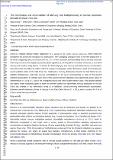Notice
This is not the latest version of this item. The latest version can be found at:https://dspace.mit.edu/handle/1721.1/131395.2
The distribution and accumulation of mercury and methylmercury in surface sediments beneath the East China Sea
| dc.contributor.author | Dong, Aiguo | |
| dc.contributor.author | Zhai, Shikui | |
| dc.contributor.author | Louchouarn, Patrick | |
| dc.contributor.author | Izon, Gareth | |
| dc.contributor.author | Zhang, Huaijing | |
| dc.contributor.author | Jiang, Xiuli | |
| dc.date.accessioned | 2021-09-20T17:16:54Z | |
| dc.date.available | 2021-09-20T17:16:54Z | |
| dc.date.issued | 2018-12-18 | |
| dc.identifier.uri | https://hdl.handle.net/1721.1/131395 | |
| dc.description.abstract | Abstract China is a massive mercury emitter, responsible for a quarter of the world’s mercury emissions, which transit the atmosphere and accumulate throughout its watercourses. The Changjiang (Yangtze) River is the third largest river in the world, integrating mercury emissions over its 1.8 × 106 km2 catchment and channelling them to the East China Sea where they can be buried. Despite its potential global significance, the importance of the East China Sea as a terminal mercury sink remains poorly known. To address this knowledge gap, total mercury and methylmercury concentrations were determined from 51 surface sediment samples revealing their spatial distribution, whilst demonstrating the overall pollution status of the East China Sea. Sedimentary mercury distributions beneath the East China Sea are spatially heterogeneous, with high mercury concentrations (> 25 ng g−1) corresponding to areas of fine-grained sediment accumulation. In contrast, some sites of fine-grained sediment deposition have significantly lower values of methylmercury (< 15 ng g−1), such as the Changjiang estuary and some isolated offshore areas. Fine-grained particles and organic matter availability appear to exert the dominant control over sedimentary mercury distribution in the East China Sea, whereas in situ methylation serves as an additional control governing methylmercury accumulation. Estimated annual sedimentary fluxes of mercury in the East China Sea are 51 × 106 g, which accounts for 9% of China’s annual mercury emissions. | en_US |
| dc.publisher | Springer Berlin Heidelberg | en_US |
| dc.relation.isversionof | https://doi.org/10.1007/s11356-018-3880-3 | en_US |
| dc.rights | Article is made available in accordance with the publisher's policy and may be subject to US copyright law. Please refer to the publisher's site for terms of use. | en_US |
| dc.source | Springer Berlin Heidelberg | en_US |
| dc.title | The distribution and accumulation of mercury and methylmercury in surface sediments beneath the East China Sea | en_US |
| dc.type | Article | en_US |
| dc.eprint.version | Author's final manuscript | en_US |
| dc.type.uri | http://purl.org/eprint/type/JournalArticle | en_US |
| eprint.status | http://purl.org/eprint/status/PeerReviewed | en_US |
| dc.date.updated | 2020-09-24T21:04:18Z | |
| dc.language.rfc3066 | en | |
| dc.rights.holder | Springer-Verlag GmbH Germany, part of Springer Nature | |
| dspace.embargo.terms | Y | |
| dspace.date.submission | 2020-09-24T21:04:18Z | |
| mit.license | PUBLISHER_POLICY | |
| mit.metadata.status | Authority Work and Publication Information Needed |
